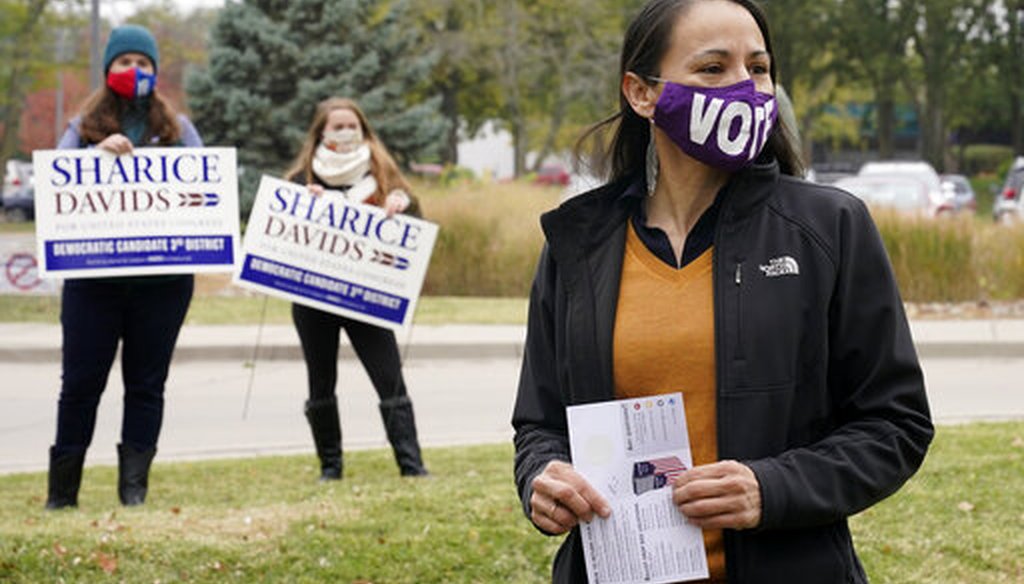Stand up for the facts!
Our only agenda is to publish the truth so you can be an informed participant in democracy.
We need your help.
I would like to contribute

Rep. Sharice Davids, D-Kan., was reelected in 2020 after flipping a Republican seat two years earlier. (AP)
If Your Time is short
• Of 43 U.S. House seats that flipped from Republican to Democratic control in the 2018 midterms, 14 flipped back to GOP control in 2020, while 29 remained in Democratic hands.
• Though data is not yet complete, there are signs that these districts’ House vote in 2020 mostly mirrored their vote for president.
• Among these seats, Democrats were generally more successful in holding districts that were more affluent, better educated, and largely suburban and urban.
Republicans unhappy about President Donald Trump’s loss in the 2020 presidential election can at least take heart in the party’s gains in the House of Representatives.
Going into election night, political handicappers had expected Democrats to add to their House majority. The Cook Political Report, for instance, predicted a 10- to 15-seat gain in its final pre-election analysis.
That didn’t come to pass. In fact, it was Republicans who gained roughly that many seats.
The gains weren’t enough to seize a House majority — with two close races still unsettled, the Republicans are on track to have between 211 and 213 seats in a chamber where 218 constitutes a majority. The Democrats have locked in at least 222 seats.
That’s down from 233 Democratic seats prior to the election, meaning that House Speaker Nancy Pelosi, D-Calif., will command only a bare majority in the coming Congress.
To understand what happened in the 2020 House races, we took a closer look at a subset of swing seats: The 43 seats that the Democrats flipped from Republican control just two years earlier, during the 2018 midterm elections.
Of these 43 seats, 14 flipped back to Republican control in 2020, while 29 remained in Democratic hands.
Here’s the list of districts that flipped back to the GOP in 2020, along with some key demographic data:
And here’s the list of the seats that remained in Democratic hands:
One pattern that emerges is that in districts where voters tended to vote for Trump, they also tended to vote for a Republican House candidate, whereas districts where voters tended to vote for Biden tended to go for a Democrat for the House.
In other words, there doesn’t seem to have been much ticket-splitting, although in close races, a small share of ticket-splitting voters could swing a House election.
"There is one overwhelming predictor of whether seats that the Democrats flipped in 2018 remained Democratic or went back to Republicans: The results of the 2020 presidential election in the district," said Emory University political scientist Alan Abramowitz. "In a presidential election year, with almost no ticket-splitting, the outcome of the presidential race determined the outcome of the House race."
It appears that the messaging by the two presidential candidates — from the anti-socialism, pro-fossil fuel, and antitax rhetoric by Trump to Biden’s attacks on Trump’s handling of the coronavirus — resonated with voters who were already predisposed to their party.
It takes time for political number crunchers to calculate how congressional districts voted in the presidential race, so we have data so far for only six of the seats on our list, compiled by the website Daily Kos Elections.
In Oklahoma’s 5th District and South Carolina’s 1st District, Trump won by at least five percentage points, and the GOP challengers won by somewhat smaller margins.
Meanwhile, in Virginia’s 2nd, 7th and 10th districts, Democratic House incumbents won reelection as Biden was carrying their district either narrowly or easily.
Only one of the six districts for which we have data so far split its ticket. That was Iowa’s 3rd District, and it was by a very narrow margin. The district backed Trump, 49.1% to 49.0%, but reelected Democratic Rep. Cindy Axne, 48.9% to 47.5%.
Rep. Cindy Axne, D-Iowa., flipped a Republican seat in 2018 and won by a narrow margin in 2020. (AP)
A similar pattern emerged if you look at how the states leaned in the presidential race.
There were four districts that elected a Democrat in 2018 despite their state's typically strong Republican lean on the presidential level. Of these, only one remained in Democratic hands this year, a Kansas district based in Kansas City’s affluent suburbs. The remaining three shifted back to GOP representatives — the Oklahoma and South Carolina districts, plus one in Utah.
However, saying that Trump voters voted Republican is a bit of a tautology. Were there more fundamental factors than partisan correlations that predicted how these swing districts voted? We found a few, and they have become familiar to students of politics in recent years.
In recent elections of all types, Democrats have made gains — and Republicans have lost ground — among voters who are more affluent, who are more educated, and who live in suburban or urban areas.
Political analyst Ron Brownstein noted in the Atlantic that "even as Democrats have improved their position inside the nation’s largest and most economically vibrant metropolitan areas, their support in exurban, small-town and rural regions has collapsed. While Bill Clinton twice won about 1,500 counties (roughly half the counties in America), Hillary Clinton carried just less than 500 (roughly one-sixth). Though Biden won the popular vote by at least 3 million more votes than she did, he only slightly expanded her geographic reach: So far, he’s carried 509 counties, based on the latest count from the Brookings Institution’s Metropolitan Policy Program."
Broadly put, this pattern holds with the seats that flipped in 2018. How the 2018 swing districts voted two years later was strongly correlated with some of the most decisive demographic factors in politics today: income, educational attainment, and whether a location is urban, suburban or rural.
Let’s take a look at each of these factors.
The median income in the districts that flipped back to the GOP in 2020 averaged just over $61,000. By comparison, in the districts that the Democrats were able to hold in 2020, the median income averaged over $78,000, or about 27% more.
Looked at another way, fewer than half of these districts with a median income below $70,000 elected a Democratic representative in 2020. But among the districts where the median income was above $70,000, a much higher share — 87% — voted Democratic.
The three affluent districts that broke the pattern and went back to the GOP in 2020 were in California: Two in Orange County, a historically Republican jurisdiction, and one in the northern Los Angeles exurbs.
Republican Michelle Steel defeated first-term Democratic Rep. Harley Rouda this year in California’s 48th district. (AP)
Collectively, in the districts that flipped back to the GOP in 2020, fewer than 30% of residents 25 and older have earned at least a bachelor’s degree. But in the districts that remained in Democratic hands, more than 41% had a bachelor’s degree.
Looking individually at the districts where fewer than 30% of residents have a bachelor’s degree, only about a quarter of them voted Democratic again in 2020. But in the districts where more than 30% have a bachelor’s degree, more than three-quarters stayed with a Democrat in the House.
Among the outliers here are three districts with lower education levels that remained blue: One heavily Hispanic agricultural district in California’s Central Valley; a district based in Des Moines, Iowa; and a largely rural district in Maine.
We also looked at the population density of each district, to see how trends varied between sparsely populated rural areas and denser suburban and urban ones. (We excluded four districts in Pennsylvania for which data on the current district lines is not available.) The differences aren’t as dramatic as they are for income and education, but there’s still a pattern.
In the 39 seats that swung in 2018 and for which we have population data, Democrats generally did better in denser — that is, more suburban and urban — districts.
Take the 23 districts that had fewer than 800 people per square mile, which are exurban or even rural. Democrats held on to 13 of those districts in 2020, or just over half. But in the 16 higher-density districts, Democrats held on to 12 seats in 2020, or three-quarters.
Among the higher-density districts that went red in 2020 were California’s two Orange County districts, a district in South Florida that’s home to a large Cuban-American community that shifted hard toward Trump this year, and a district in New York City’s Staten Island borough that’s home to more conservative white ethnic residents than other parts of the city.
Our Sources
Almanac of American Politics 2020
Cook Political Report, "2020 National House Vote Tracker," accessed Dec. 4, 2020
Cook Political Report, "Final House Ratings: Democrats Poised to Expand Majority by 10 to 15 Seats," Nov. 2, 2020
New York Times, "U.S. House Election Results," accessed Dec. 4, 2020
Daily Kos Elections, "Presidential Results by Congressional District for 2020, 2016, and 2012," accessed Dec. 4, 2020
U.S. Census Bureau, "My congressional district" tool, accessed Dec. 4, 2020
Ron Brownstein, "Democrats’ Real Liability in the House," Nov. 27, 2020
FiveThirtyEight.com, "There Wasn’t That Much Split-Ticket Voting In 2020," Dec. 2, 2020
Cook Political Report, "Density as Destiny?" Dec. 2, 2020
Charlie Cook, "Voters' Message: Don't Be a Jerk, Don't Be a Socialist," Nov. 27, 2020
Email interview with Richard Cohen, chief author of the Almanac of American Politics, Dec. 3, 2020
Email interview with Alan Abramowitz, Emory University political scientist, Dec. 4, 2020














































